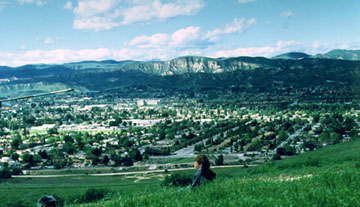SIMI VALLEY

The Pioneer Period in Simi Valley began as easterners began to look around Southern California for land to farm. In the 1860's and 1870's a few Americans began to trickle in; first they continued the raising of sheep and cattle, much as the Spanish had done, and then raising grain. In the late 1880's the real settlement began. Simi Land and Water Company was formed to dispose of the land in the first real estate promotion. A large hotel was built in which persons investigating the real estate could stay while in the valley. The company advertised extensively and some of their ads in other areas reached Chicago, Cincinnati, and the New England states. A group of Chicago doctors, noting the promises of fine weather, etc., decided to come out and start a health resort or sanatorium on the banks of Simi Arroyo, for the ads had shown a river of considerable size, large enough to accommodate a paddle wheel steamer! The group of doctors arranged to have twelve prefab or ready cut houses sent west by rail to Saticoy, and then hauled to Simi by wagon, while the settlers themselves took advantage of the low rates on the railroad. At one time passage west was as low as $1 on one railroad line and $8 on the other line, as they competed for trade!
The colony of doctors, called the California Mutual Benefit Company of Chicago, did not really materialize and many returned to their former homes in the Chicago area, but the name stuck. For many years, the little town was referred to as "The Colony", and the houses have always been known as "Colony Houses". Two of them still exist. One is preserved here in our park and the other is still occupied on the corner of 2nd and Pacific.
Eventually there were four small settlements or centers of activity in the valley. First was the Colony, or town of Simi. For a brief time, its postal address was known as Simiopolis, though it was soon shortened again to Simi.
Talk of a railroad for the next decade or so finally resulted in the decision by Southern Pacific Railroad to build a tunnel through the Santa Susana Mountains. This made a depot necessary in the area, and the town of Santa Susana came into being. The depot was completed first at the crossroads of Tapo Street and Los Angeles Avenue. While the tunnel was being worked on, trains would come up from the west and then return the same way. Finally in 1904 the tunnel was ready for use and this became the main line of the railroad.
Santa Susana rapidly became a center for agriculture and railroad activity. Stores, warehouses, lumberyards, section houses for the railroad crews, and a little later, a walnut processing plant and a citrus house went in nearby. None of these buildings are now in existence.
By the early 1920's Mortimer Park, later changed to Santa Susana Knolls, was started. Mr. Mortimer had a idea for vacation size lots on which people from the city could build country homes. This area has always been one of the most picturesque in the valley.
In the mid 1920's a Community Center was created. A large cement church was built and the Simi Women's Club building was moved nearby in the middle of the valley. Until the later population boom began, this area truly was the center for most of the social and cultural activities in the community and was known as "Community Center". These street names came into being: Church Street, School Street, Deodora Street and others.

CLICK HERE for HOME page.


